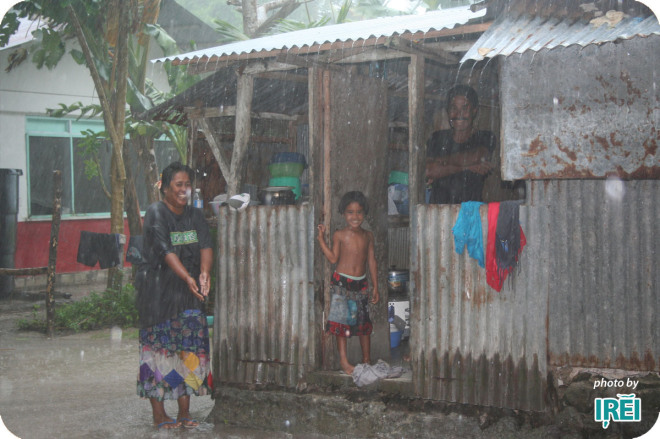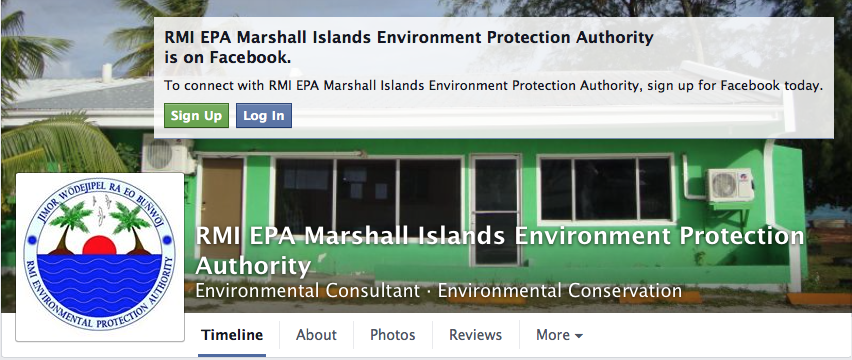Dr. Ethan Allen discusses water with Jay Fidell on ThinkTech Hawai’i.
Construction of a Catchment System
As we prepare for a likely drought next year, it’s well worth reviewing the great WERI (Univ. of Guam) monograph on how to build a sturdy, simple, inexpensive rainwater catchment system – see Construction of a water tank for Micronesia
And see also, for figuring areas, water needs, etc.
http://www.weriguam.org/reports/item/designing-your-rainwater-catchment-and-storage-system-for-rainwater-catchment-systems-in-saipan.html
Another Example of Why Water for Life Work is Important
From Pacific Island Report Briefs
Floods Leave Half Of Honiara Without Access To Water
Weeks of repairs expected to be required to restore supply
MELBOURNE, Australia (Radio Australia, April 9, 2014) – Authorities say it could be weeks before water supplies to the capital of Solomon Islands are restored. Last week, unprecedented flooding in the Pacific island nation claimed the lives of 23 people and left 9,000 homeless. It also wreaked havoc on Honiara’s water mains, with around 50 per cent of the city now unable to access water, and pipes to one of the main water supply depots broken. Solomon Water General Manager Richard Austin said parts of the water system have been completely destroyed. “We have two levels of problem,” he told the ABC. “We’re dealing with the amount of water available in Honiara, generally, but also … provid[ing] safe basic quantities of drinking water to the evacuation centres.” Australian Foreign Minister Julie Bishop has announced a $3 million aid package to help the flood recovery.
PACIFIC LAGGING IN MDGS FOR SAFE DRINKING WATER, SANITATION
![]()
Pacific Islands Development Program, East-West Center
With Support From Center for Pacific Islands Studies, University of Hawai‘i
Pacific Lagging In MDGs For Safe Drinking Water, Sanitation
Regionally, Pacific tied with Sub-Saharan Africa for lowest level
WELLINGTON, New Zealand (Radio New Zealand International, March 25, 2014) – UNICEF New Zealand says four years after the Millennium Development Goals’ global target for safe drinking water was met, the Pacific is still lagging far behind.
As World Water Day was marked this week, the executive director, Dennis McKinlay, says many people in the Pacific do not have access to their basic right of water and sanitation.
He says the Pacific is tied with Sub-Saharan Africa as having the lowest level of improved sanitation in the world.
Mr McKinlay says the Pacific is far off track to achieving either its sanitation or water Millennium Development Targets by 2015.
“It’s still a problem accessing safe water. The Pacific Islands generally do not have good water systems and partly that’s because of the dispersed nature of the population across many small islands, it makes it hard to service them.”
Dennis McKinlay says it is likely the post-2015 goals will see more country-specific targets, not just global ones.
Radio New Zealand International
Copyright © 2014 RNZI. All Rights Reserved
SOLAR POWERED SEAWATER DESALINIZATION
A dialog on an emerging technology to produce drinking water from seawater:
FROM THE YAP STATE NEW BRIEFS
Yap To Observe International World Water Day
COLONIA, Yap (Media Division) — March 22, 2014 is International World Water Day and the Water for Life project team wishes to bring your attention to the importance of water and sustainable management of our water resources.
The Water for Life team, which comprises the Yap State Public Service Corporation, Southern Yap Water Authority and the Gagil-Tomil Water Authority, are working together to protect and manage Yap’s water resources in collaboration with the Pacific Resources for Education and Learning (PREL). This project is funded by the National Science Foundation.
In observance of this event, the Water for Life team has created fliers for public dissemination and shared announcements on the radio.
In its message, the Water for Life team shares that World Water Day is held every year on 22 March to focus global attention on the importance of water and advocating for the sustainable management of our water resources. Since 22 March falls on Saturday this year, International World Water Day will be observed on Friday 21 March.
An international day to celebrate freshwater was recommended at the Earth Summit in 1992. The UN General Assembly responded by designating 22 March 1993 as the first World Water Day, and it has been held annually since then.
Water holds the key to sustainable development. We need it for health, food security and economic progress. Yet, each year brings new pressures.
Future climate change projections for the FSM over the next 15 to 35 years show (i) average air temperature will increase by 1.7 – 3.3 degree Fahrenheit, (ii) an increase in the number of very hot days, (iii) a decrease in cooler weather, (iv) increase in average annual rainfall with increases in wet and dry season rainfall, (v) increase in sea surface temperature, and (vi) sea level will continue to rise. Projections about the future behavior of typhoons and the ENSO phenomena show a significant range of uncertainties at the moment.
Ninety-seven percent of all the water on the Earth is saltwater which is not suitable for drinking. Only 3 percent of all the water is freshwater, with about 30 percent of this is underground and 70 percent locked in icecaps and glaciers. Only 1 percent of that 3 percent is readily available as drinking water. We must learn to save water now for the future. The quality of our water is very important.
Climate change and the needs of populations growing in size and prosperity mean we must work together to protect and manage this fragile, finite resource.
Only less than 300 days are left before the Millennium Development Goal deadline of 2015. But 2015 is not a finishing line, merely a milestone in a long and challenging journey. As we develop the post-2015 development agenda, our aim is to eradicate extreme poverty and hunger, and to create an equitable world of opportunity for all. To do that, we need to give equal consideration to the environmental dimension of sustainable development.
Conserving the water that we have minimizes the effects of water shortages and helps build a better defense against future drought years. If we save water now, we are helping to ensure a water supply adequate for future generations. Saving water saves money.
We cannot prosper without clean, plentiful freshwater. On this World Water Day, let us salute those folks who work relentlessly with our three main public water systems on Yap to provide us clean drinking water. But at the same time we appeal for everyone for heightened cooperation. Water is a common resource. Let us use it more intelligently and waste less so all get a fair share.
For more information on water conservation, contact the Yap State Public Service Corporation, Southern Yap Water Authority or the Gagil Tomil Water Authority on 350 7151, 350 2711, 350 5544 or 350 4382.

WORTH LOOKING INTO?
An interesting article suggesting that a simple bit of wood can be used as an effective, bacterial blocking water filter. http://www.popularmechanics.com/science/environment/water/a-simple-tree-branch-can-become-a-backyard-water-filter-16540288
Might be developed into some interesting experiments or demonstrations.

REFRESHING RAIN
I love this photo from Pakin atoll, one of the outer islands of Pohnpei. It is nice to see this family enjoy the refreshing and plentiful rain, especially considering that Pakin has been known to run out of fresh water supplies in the past. Hidden under vegetation in the atoll forest are remains of PVC pipes used to pump water from a relief ship to the island during one of the past droughts.
WATER RATIONING IN PALAU
[Pacific Islands Report briefs for Tuesday, October 15, 2013]
Palau Utilities Corporation Announces Water Rationing
Entirety of Koror, Airai to be restricted from 9 pm to 4 am
KOROR, Palau (Island Times, Oct. 14, 2013) – Palau Public Utilities Corporation (PPUC) yesterday issued an update on the water situation, announcing that the water will be shut down starting 9 pm until 4 am. across Koror and Airai. Earlier, PPUC had announced water would be restricted from 11 pm to 4 am, and only residents in Idid, Meketii, Ikelau, Dngeronger, Ngerbeched, Medalaii, Malakal and Meyuns would be affected. PPUC Water and Wastewater Operations Public Relations Coordinator John Kintaro Jr. said during the briefing yesterday that the Ngerkesewaol tank was nearly empty, necessitating rationing for all Koror and Airai. There are four tanks that distribute water to Koror and Airai, with Ngerkesewaol holding 1 million gallons and the other three holding about half that. Kintaro Jr. said water would be shut off for seven hours daily to ensure the tank is refilled by the others during the shutdown. He also said, since last week, the water level in the Ngerkesewaol tank has been decreasing significantly, and one or more leaks may be contributing to the problem. Kintaro Jr. also said PPUC is working day and night to monitor water levels and identify possible leaks, although none have yet been found. The public was also warned water color may change during rationing, and any water for consumption should be boiled before use. In February, water rationing was also implemented in parts of Koror after Ngerkesewaol tank water levels dropped drastically. Several leaks, which were then repaired, were identified as the cause.

